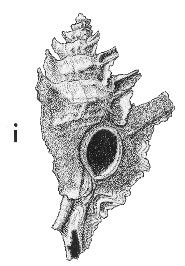
Revised descriptions of New Zealand Cenozoic Mollusca from Beu and Maxwell (1990)

 | Revised descriptions of New Zealand Cenozoic Mollusca from Beu and Maxwell (1990) | 
|
  (Pl. 48i): specimen figured by Fleming (1962b, pl. 1, fig. 16), Tainui Shellbed, Castlecliff, Castlecliffian (TM3117, GNS) |
Beu & Maxwell (1990): Chapter 16; p. 358; pl. 48 i.
Synonymy: Typhis zealandica Hutton 1873b, p. 2; Murex angasi of Suter, not of Crosse; Pterynotus (Pterochelus) zealandicus; Ponderia zealandica; Pterotyphis (Ponderia) zealandicus, Beu & Maxwell 1990, p. 358, pl. 48i.
Type species of Ponderia Houart, 1986
Classification: Muricidae: Tripterotyphinae
Description: Small for family (25-35 mm high), similar in size and most other characters to Prototyphis angasi (see above), but with more prominent nodules on shoulder angle, longer closed, completely tubular shoulder spines on varices, closed, tubular anterior canal, and so aperture a complete oval with raised, thickened, continuous peristome, not interrupted by anterior and posterior canals as in P. angasi. Modern specimens cream or white, not brightly coloured as in P. angasi. Protoconch as in P. angasi, but with flat rather than concave apex.
Comparison: Although Ponderia zealandica has previously been considered closely related to Prototyphis angasi, Houart (1986) pointed out that the long, closed shoulder tube and anterior canal show that this belongs in a different species group, for which he provided the generic name Ponderia. Houart (1986, 1988, 1990) has included the following species in Ponderia: P. abies Houart, off New South Wales, 154-164 m; P. canalifera (G.B. Sowerby II, 1841) (= iredalei Fleming, 1962), Norfolk Island; P. caledonica Houart, New Caledonia; P. magna Houart, New Caledonia; and P. elephantina Houart, Coral Sea. This therefore turns out to be a distinctive, restricted, Southwest Pacific genus.
Distribution: Castlecliffian-Recent; "Shakespeare Cliff, Wanganui", Castlecliffian (type), certainly from Tainui Shellbed, the sole formation where it has been collected subsequently at Wanganui. Uncommon but consistently collected in Tainui Shellbed, rare living in Cook Strait (about 20 specimens in NMNZ) and off East Cape, in c. 55-170 m. Tainui Shellbed is an off-shore, current-swept shell accumulation, probably representing a succession of minor "hard-ground" environments (oysters and Barbatia are common here, only, among Castlecliff formations, and the shellbed was known to early collectors as "the oyster bed") and the shelly "lag gravel" environment appears to have been similar to those in which living specimens of P. zealandica have been dredged.
Cite this publication as: "A.G. Beu and J.I. Raine (2009). Revised
descriptions of New Zealand Cenozoic Mollusca from Beu and Maxwell (1990). GNS
Science miscellaneous series no. 27."
© GNS Science, 2009
ISBN
978-0-478-19705-1
ISSN 1177-2441
(Included with a PDF facsimile file
copy of New Zealand Geological Survey Paleontological Bulletin 58 in CD version
from: Publications Officer, GNS Science, P.O. Box 30368 Lower Hutt, New
Zealand)